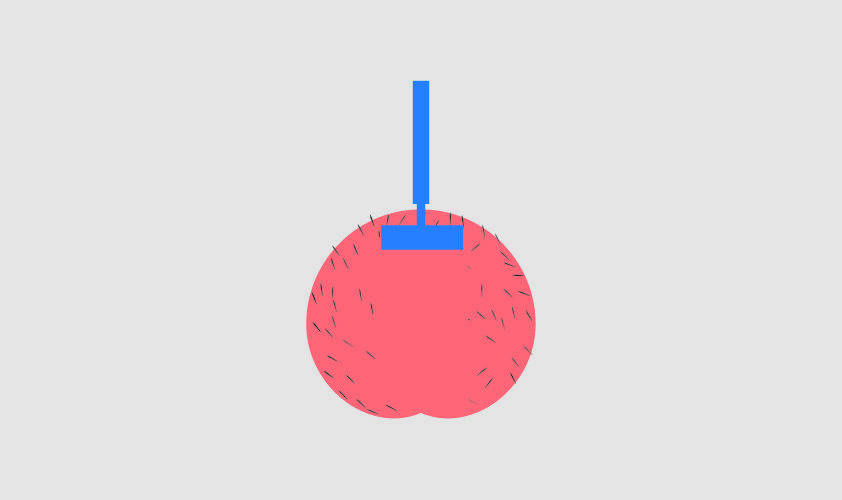Hairy or not?
Hair grows all over your body and is completely normal, even on your buttocks and between your butt cheeks. This type of hair is called vellus hair, and it exists to protect your skin. It is thinner and lighter than normal hair but is also much smaller.
Everyone has some hair in the area between their butt crack. This hair absorbs moisture and protects the sensitive skin around your anus. In this area, hair can be thick or dark but it can also be fine and harder to see (such as vellus hair), this depends on several factors.
- Genetics: hair type and pattern of growth have a lot to do with genetics. Family history largely determines the color, thickness, and amount of hair that grows on the buttocks and between the butt crack;
- Medications: some medications like corticosteroids (prednisone) or those for hypertension (minoxidil) can stimulate thicker body hair growth;
- Hormone conditions: out-of-balance hormones can result in irregular hair growth patterns, which is why medical conditions that impact the endocrine system can cause increased hair growth in the body. These conditions include hypertrichosis: a rare condition that can cause excessive hair growth anywhere on the body.
However, there’s no medical need to remove hair that grows in sensitive areas like your intergluteal cleft, but having a lot of hair there might make you feel self-conscious or uncomfortable.
Deciding to remove hair in your butt crack can have different reasons:
- A smooth, hairless feel all over their body, including the butt and the surrounding area;
- A lot of sweat from the lower back;
- Feeling less self-conscious during sexual activity without hair.
Anyway, there is no medical or hygienic advantage to getting rid of hair anywhere on your body, including your butt. In fact, you should be aware that getting rid of this hair by shaving, bleaching, or waxing carries certain risks.
Getting rid of hair between your buttocks requires more care and sensitivity than body hair removal in other areas and some techniques of hair removal are not recommended for this area.
Shaving: shaving the area between your butt cheeks is hard to do safely, but not impossible. For one thing, it’s hard to see what you’re doing when you shave back there. Shaving cream often has fragrance ingredients, which can trigger allergic reactions and dry out sensitive areas of your skin. A clean razor, a handheld mirror, and warm running water can make it possible to get a clean shave in this area, but you’ll need to be very careful. Trim the area with small, sanitized safety scissors and wash with warm water with a washcloth before you get started.
Laser: some people opt for laser hair removal on their butt crack but this requires repeated treatments from a professional and it may get expensive, when performed correctly, it should lead to a permanent reduction in hair in the area treated.
Waxing: you can have a professional aesthetician wax the area between your butt cheeks, or you can wax it yourself at home. A butt crack area wax is typically included in most Brazilian bikini wax treatments. Keep in mind that the skin of your butt crack hasn’t been exposed to a lot of heat and will burn more easily than other parts of your body.
Electrolysis: electrolysis on your butt crack is safe when performed by a certified aesthetician or cosmetologist. You will need several treatments, and it is not cheap but it may also be painful. In addition, the results of electrolysis are permanent. Epilators and depilatory creams are typically not recommended for use on your butt crack area. These methods of hair removal can be extremely painful and cause bleeding, burning, and other uncomfortable side effects. Speak with a dermatologist if you’re considering an alternative method of hair removal for your butt crack.
Getting rid of the hair on your butt crack is not free from risks and side effects, for example:
Itching: as the hair between your butt cheeks grows back, it can feel itchy and uncomfortable. You may also notice razor bumps or a slight rash, sometimes due to soap or shaving cream getting into the area.

Irritation and burning: if you use the toilet and need to wipe soon after removing hair from the perianal area, you may notice that the area feels irritated and can also result in a sensation of burning or warmth that takes a few hours to subside.
Razor burns and ingrown hairs: when you remove hair, razor burns, and ingrown hairs may occur. Removing hair from your butt crack without shaving cream makes razor burns more likely. So, due to your butt shape, you may notice that you are more prone to ingrown hairs in that area, as the skin is pressed most of the time. Moreover, ingrown hair can also turn cystic.
Infection: your butt crack borders your anus, making infection a concern. So, if you cut yourself while shaving there, you may wipe dangerous bacteria into the area of your injury. If bacteria from sweat gather in your butt crack, it could turn ingrown hair into an infected hair follicle.
In short, removing hair is a matter of aesthetics but if you feel uncomfortable or discomfort about it you can remove it making sure to do it carefully because of possible risks of side effects.
Source healthline.com
